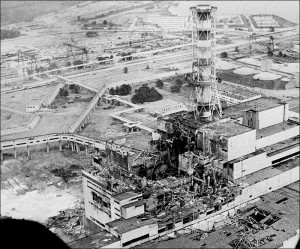What is the 3rd Trumpet?
The third angel sounded his trumpet, and a great star, blazing like a torch, fell from the sky on a third of the rivers and on the springs of water— 11 the name of the star is Wormwood. A third of the waters turned bitter, and many people died from the waters that had become bitter. Revelation 8: 10-11)
Some people believe that the “blazing torch” that falls from the sky will be a meteor called “wormwood.” While that is a possibility, there is reason to believe that the 3rd Trumpet might actually describe the world’s most devastating nuclear accident: Chernobyl (1986).
Chernobyl Nuclear Accident
The first and worst nuclear accident in the history of mankind occurred in Russia on April 26, 1986. On that day, existing fail-safe systems were disabled in order to conduct a test. The test failed. The resulting explosion had a devastating impact.
Wormwood
The Russian word for “Wormwood” is “Chernobyl.”
A Blazing Torch
A nuclear power plant explosion could easily resemble a blazing torch. If the explosion went high into the air and fell back to earth, it could have appeared as though the blazing torch fell from the sky.
Bitter Waters
When the nuclear reactor exploded it released radioactive particles into the atmosphere. Smoke and wind carried the radiation into much of Russia and Western Europe. Radioactive rain contaminated the ground and surface waters. Four hundred times more radioactive material was released from Chernobyl than by the atomic bombing of Hiroshima.[i]
The government of the Soviet Union did not publicly acknowledge the nuclear accident until two days later when radiation levels set off alarms at the Forsmark Nuclear Power Plant in Sweden,[ii] over 620 miles from the Chernobyl plant. As a result of the disaster and delay in warning people, about 3.5 million people received serious exposure to radiation. Radiation exposure occurs from breathing contaminated air, drinking contaminated water, eating contaminated food, and touching contaminated surfaces.
There were long term affects from the nuclear explosion (e.g. birth defects, cancer, chronic illnesses). Between 1986 (the year of the accident) and 2004, there were 985,000 premature deaths as a result of the radioactivity released.[iii]
Long Term Effects
A radioactive wasteland, surrounds the nuclear plant. Ukrainian officials estimate the area will not be safe for human life again for another 20,000 years.[iv]
The effort to contain the contamination cost about $18 billion dollars and virtually bankrupted the Soviet Union.[v] Over a period of 30 years, ongoing costs related to the disaster are estimated to be about $235 billion dollars.[vi]
The Chernobyl disaster was a key factor in the dissolution of the Soviet Union (the USSR) in 1991, and a major influence in shaping the new Eastern Europe.[vii]
Future Significance
Near the end of this age, there will be a war in which a third of mankind is killed (see the 6th Trumpet). Based on today’s technology, a war that devastating could very likely involve nuclear weapons. If the people who start the war don’t have access to nuclear weapons, they are likely to fall back onto their second choice: the melt down of nuclear power plants.
The Chernobyl nuclear accident provides an example of what can happen to geographical areas near a nuclear power plant. In addition, it offers insights into what preparations may be needed to prevent and/or survive such an incident.
References:
[i] “Facts: The accident was by far the most devastating in the history of nuclear power”. Ten years after Chernobyl : What do we really know?. International Atomic Energy Agency (IAEA). 21 September 1997. Retrieved 20 August 2011.
[ii] “Chernobyl haunts engineer who alerted world”. CNN Interactive World News (Cable News Network, Inc.). 26 April 1996. Retrieved 28 April 2008.
[iii] “Details”. Annals of the New York Academy of Sciences. Annals of the New York Academy of Sciences. Retrieved 15 March 2011.
[iv] Time: Disasters that Shook the World. New York City: Time Home Entertainment. 2012. ISBN 1-60320-247-1.
[v] Gorbachev, Mikhail (1996), interview in Johnson, Thomas, The Battle of Chernobyl on YouTube, [film], Discovery Channel, retrieved 19 February 2014.
[vi] “Chernobyl’s Legacy: Health, Environmental and Socia-Economic Impacts and Recommendations to the Governments of Belarus, Russian Federation and Ukraine” (PDF). International Atomic Energy Agency – The Chernobyl Forum: 2003–2005. Retrieved 31 July 2010.
[vii] Petryna, Adriana (2002). Life Exposed: Biological Citizens after Chernobyl. Princeton, NJ: Princeton University Press.

Leave a Reply